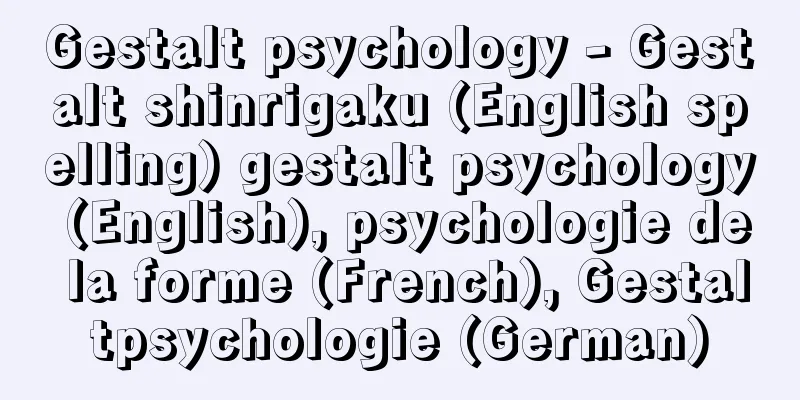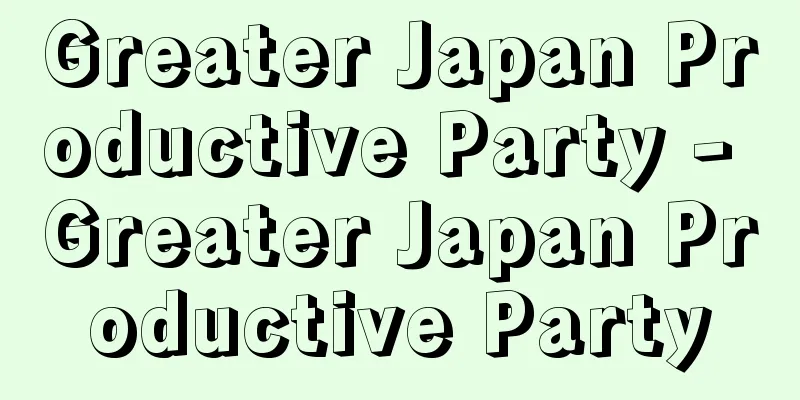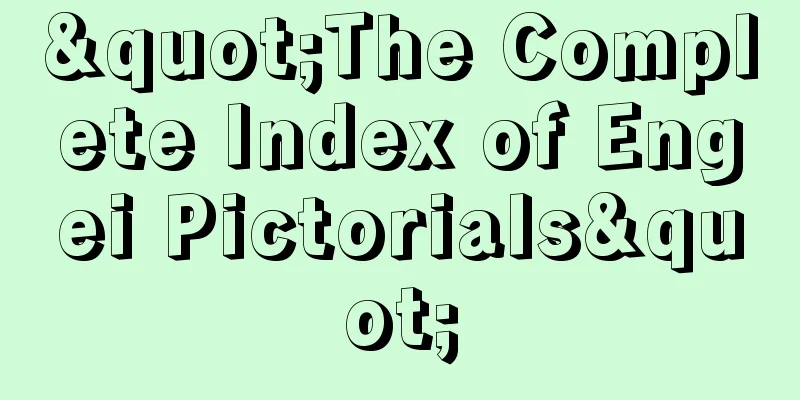Gestalt psychology - Gestalt shinrigaku (English spelling) gestalt psychology (English), psychologie de la forme (French), Gestaltpsychologie (German)

|
Gestalt psychology is a school of thought in psychology that places emphasis on the structure and wholeness of an object, rather than on its parts or components, when it comes to the formation of perception and cognition. It was founded in Germany in the 1910s by M. Wertheimer, and rejected the idea of "elementism" represented by Wundt, W., which states that "mental phenomena are composed of the sum of elements," calling it the "mosaic hypothesis" and "bundle hypothesis." Gestalt psychology was founded in 1912, when Wertheimer published a paper on "apparent movement," an experiment he conducted with the help of W. Köhler and K. Koffka. The background to its establishment includes the identification of "Gestalt nature" by C. Ehrenfels von, and "experimental phenomenology" represented by D. Katz and E. J. Rubin. "Gestalt" is a German word meaning form or shape, but here it means the structural characteristics of a cohesive whole that cannot be reduced to elements. Wertheimer (1925) states that "within a whole there are interrelationships (and their manifestation) that are specific to it, and these are not determined by the behavior of the individual parts (elements) or by the set of parts. How a part of the whole appears is determined by the properties (internal structural laws) of the whole." [Gestalt quality] Also translated as form quality. At the end of the 19th century, when the limitations of elementalism began to be recognized, physicist E. Mach, who considered the sensation to be the starting point of all science, pointed out in his book "Contributions to the Analysis of Sensation" (1886) that the sensation of shape and melody does not change even if the elements that make up the sensation change. Ehrenfels developed this idea of Mach and published a paper "Über Gestaltqualitäten" (1890). A triangle will look like a triangle even if its color or size is changed as long as the three sides are kept in a certain relationship, and even if a melody is transposed, it will sound the same melody. He called this characteristic "transposability" and claimed that a whole has a certain quality as a whole, that is, a gestalt quality, even if the parts and elements that make up the whole change. The fact that one can memorize a melody but has difficulty remembering its individual sounds is also a manifestation of this property, and in this case the explanation that sees a melody as the sum of the representations of individual sounds does not hold up. Unlike Mach, he did not see shape and melody as independent sensations, but rather as sensations corresponding to each element, and that new Gestalt properties arise from the sum of these elemental sensations, which led to criticism from Gestalt psychology that this still retained an elemental view. [Experimental phenomenology] The philosopher Husserl, E., was influenced by Kant, I. and Hegel, GWF, and applied phenomenology to the study of direct experience. It is said that Stumpf, C. was largely responsible for introducing the method into psychology in the early 20th century. However, tracing the history of visual research, phenomenological research was already being conducted in the 19th century, mainly by physiologists, except for Goethe, such as Goethe, JWvon's many observations on color, Purkinje, JE's observations on the Purkinje phenomenon, and Hering, E.'s research on brightness and color. Experimental phenomenology uses experimental methods to set stimulus conditions and their systematic changes, and observes and describes the phenomenon itself as it is, without taking a specific analytical attitude. In the early 20th century, representative research was conducted from this standpoint to pursue phenomenal characteristics that cannot be understood only from peripheral physiological processes. Jaensch, ER's research on vision and depth perception is one example. Katz's paper "The Appearance of Color" (1911) clarified that color and space are related to each other, and that the main ways in which color and space appear are: 1) surface color: as the color of the surface of colored paper or objects, it allows the orientation of distance and gives a sense of opacity; 2) area color (film color): like a clear blue sky, it has no sense of substance and you feel as if you can enter it; and 3) space color: like a transparent colored liquid in a glass or a block of colored glass, there is a sense of color inside as well. Rubin, E, J. began studying the phenomenon of figure-ground differentiation around 1912, and in his book "Visually Perceived Figures" (1921), he clarified the phenomenal characteristics of figure and ground. The figure-ground reversible figure known as "Rubin's cup" is shown in this book, but it appears completely different depending on whether the same part becomes the figure or the ground. These studies were, if anything, experimental phenomenological studies conducted within the scope of a specific topic. In contrast, it was Wertheimer who clearly demonstrated the experimental phenomenological position in psychology more generally. [Wertheimer's Experiments on Apparent Movement] Wertheimer demonstrated the idea of Gestalt in his experiments on apparent movement (Scheinbewegung, or apparent movement) (1912), which began with the observation of a surprise board, and revealed a phenomenon that could not be understood from the one-to-one addition of stimulus elements and sensory elements. Köhler and Koffka were the participants in this experiment. Apparent movement is the movement seen in animated films, where still images are reproduced frame by frame at short time intervals, causing the image to appear to move. This phenomenon itself was already known at the time and had been studied, but Wertheimer organized the conditions for his experiment. He presented simple stimuli, such as two parallel lines (a, b) or two lines forming an angle (a, b), one after the other, with a certain time interval between them (e.g. 20 milliseconds). As a result, when the time interval is too short (about 30 milliseconds), the two are seen at the same time (simultaneous phase), and when it is long (about 200 milliseconds), they are seen one after the other in each place (sequential phase), but within a certain range (about 60 milliseconds) various movements appear, and it was found that there are conditions under which smooth movement from one to the other can be seen (optimal phase). This kind of apparent movement is called the phi phenomenon. Noting that smooth movements do not only involve the appearance of a single line moving, but also include a phenomenon in which only the "movement" itself from place a to place b is felt without any impression of a line, this phenomenon was called pure phi reine φ. The experiment was conducted by systematically changing the time interval, spatial sense, presentation time, shape, color, and arrangement of the two stimuli, as well as the attention and attitude of the participants, and it was found that apparent movement cannot be distinguished from actual movement that occurs when the stimuli actually move, that it can be observed when it occurs simultaneously in two different directions, and that it occurs even when the two stimuli are presented to different eyes. From these results, he concluded that apparent movement cannot be explained by peripheral mechanisms, and based on the physiological knowledge of the time, he hypothesized that the phi phenomenon corresponds to a higher-level central physiological process resulting from the horizontal interaction between two stimuli. Although it was impossible to verify this at the time, such a hypothesis was an ambitious inference not found in traditional psychology. The significance of this experimental observation of apparent movement is that it showed a phenomenon that could not be explained by elementalist psychology up to that point. The two stimuli a and b remain physically stationary, and there is no stimulus element that corresponds to the phi phenomenon. In other words, it cannot be explained by separate processes caused by individual stimulus elements, but is considered to be a process brought about by the entire spatiotemporal pattern of the two stimuli. Mental phenomena are a whole with a dynamic structure, forming a certain Gestalt. The nature of a part can change depending on how it is positioned within the whole and what role it plays as a part. Based on this idea, he denied the constancy assumption (Konstanzannahme), which is asserted by elementalism, that a certain stimulus and a certain sensation have a one-to-one constancy relationship. It is clear that the constancy assumption cannot explain the phenomenon of constancy or contrast in perception. The establishment of Gestalt psychology, including subsequent research, was the work of three people: Wertheimer, Köhler, who cooperated in the experiments on apparent motion, and Koffka. All of them emigrated from Germany to the United States around 1930 due to the rise of the Nazis. [Köhler's research] 1) Insight and transposition in animals After meeting Wertheimer at the University of Frankfurt, where the apparent movement experiments were conducted, Köhler served as director of the Ape Research Institute in the Canary Islands in Africa from 1913 to 1920, during which time he closely observed the problem-solving behavior of chimpanzees. The result of this work was Intelligenzprüfungen an Menschenaffen (1917). He described the behavior of chimpanzees using tools and making tools, such as pulling a banana to them with a stick, joining two short sticks to make one long stick, carrying a box from a distant place to get a banana hanging high up, and stacking boxes when the height was not enough. He argued that such problem-solving behavior was not achieved by trial and error based on past chance success, but rather showed insight into the means-goal relationship at the time. Insight means that the entire scene is reorganized and that relationships between the object and the self, or between objects, are recognized as being useful for adaptation. In learning experiments on brightness and size with chicks and chimpanzees, the phenomenon of transposition was found, suggesting the recognition of relationships between stimuli, in which the brighter or larger of two stimuli was selected, rather than the absolute properties of each individual stimulus. This phenomenon, too, cannot be understood under the constant assumptions of elemental psychology. ⑵ Psychophysical isomorphism This is a hypothesis that Wertheimer had already suggested in relation to the phi phenomenon, but that Köhler proposed in his book Physical Gestalt in the Rest and Stationary State (1920). He focused on the physically determined physical processes discussed in the field theory of physicists Maxwell, JC and Planck, M., and pointed out that organized perceptual events and their corresponding cerebral cortical processes have common structural characteristics. In other words, he argued that Gestalt properties exist not only in mental phenomena but also in the physical world, and therefore that a correspondence should exist between central nervous processes governed by physical laws in a broad sense and the world of phenomena. Therefore, the study of mental phenomena makes it possible to infer corresponding physiological processes. This hypothesis was criticized as a cerebrum myth, but in his later book Dynamics in Psychology (1949), he expanded on this hypothesis, leading to the discovery of a visual phenomenon called the figural after-effect. Kanizsa, G. (1979), an Italian who inherited Gestalt psychology, said about the psychophysical isomorphism hypothesis that when evaluating Gestalt psychology from the perspective of scientific merit, it must be remembered that the isomorphism hypothesis is a hypothesis, that the principles of Gestalt theory were discovered and elaborated in the phenomenal domain, and should be verified and rejected in that domain, and therefore, even if it is shown that Kohler's hypothesis is incorrect and therefore that the principles of the theory cannot be directly applied to physical and physiological processes, the principles of Gestalt theory will continue to have scientific value in the phenomenological domain. [Koffka's research] In his book The Foundations of Mental Development: An Introduction to Child Psychology (1921), Koffka discussed education and the learning process from the perspective of Gestalt psychology. His first English paper, Perception: An Introduction to Gestalt Psychology (1922), was the first to introduce the basics of Gestalt theory to the English-speaking world. In his major work Principles of Gestalt Psychology (1935), which aimed to systematize the theory, he made psychology a science of behavior and, although he took the position of psychophysical isomorphism, he emphasized the analysis of the world of phenomena or behavior rather than the pursuit of physiological correspondence processes. He considered behavior to occur not as a set of responses to stimuli, but as a result of a dynamic system in which changes in one part affect all other parts. Such a field is the world as perceived by the person, that is, the behavioral environment. Regarding the development of perception, he argued that even one-month-old infants are interested not in simple stimuli, but in human voices and faces, and that their perception is not a collection of simple sensory elements, but already appears as some sort of structured whole. This point is in line with the results of subsequent research in infant psychophysics. He argued that development is a process of restructuring situations in order to adapt to diverse situations, and that this is not an additive process but a differentiation process, and that the foundation that supports this is maturation. [Lewin's research] Many people came to accept Gestalt psychology, and Lewin, K. is one of them, who is unique in proving the wide-ranging effectiveness of Gestalt theory in areas such as needs, willpower, emotional processes, and personality. Like the three mentioned above, he emigrated from Germany to the United States. He applied field theory to small group research, and proposed group dynamics, which assumes a dynamic process in which changes in individuals as parts affect the group as a whole, and changes in the group affect individuals. He conducted experimental manipulations and descriptions of leadership, group goals, decision-making, atmosphere, cohesion, and so on, and contributed to the development of social psychology. [The Succession of Gestalt Psychology] Gestalt psychology was born with visual perception as its central field, but it soon expanded to include memory, thinking, needs and behavior, group characteristics, and other areas, and its basic understanding of mental phenomena is considered one of the origins of modern psychology. In the second half of the 20th century, the focus was on the field of perception, just as it was in its early days. An example of this is the Italian visual perception research represented by Benussi, V., Musatti, CL, Metelli, F., and Caniza. 1. Metzger, W.'s visual research and relational systems theory Having Wertheimer and Köhler as his teachers at the University of Berlin, the German Metzger represents the continuity of Gestalt psychology from its heyday. The focus of his research is on visual perception, but he also developed methodological and theoretical considerations across a wide range of fields, including education for development, productive thinking and creative activity, psychotherapy, and psychological aesthetics, and made practical recommendations. The results of his work over the course of more than 30 years, from 1950 to 1982, are summarized in the magnum opus Gestalt-psychologie (1986). ⑴ Visual research Wertheimer's book Gesetze des Sehens (Laws of Seeing) details many of his research results based on the Prägnanz tendency (see the section on Gestalt factors) with a wealth of illustrations. The second and third editions (1953 and 1975) of this book were significantly expanded from the first edition (1936), with 2.7 and 3.9 times the number of pages and 2.9 and 3.6 times the number of illustrations, respectively. 38 years after the second edition (1968) translated by Morinaga Shiro, Spillmann, L. published the English translation of the first edition, Laws of Seeing (2006). (2) Relational system, system of reference As mentioned above, perceptual phenomena do not have a one-to-one correspondence with stimuli, i.e., the assumption of constancy is denied. The concept of relational system was proposed regarding the establishment of such perceptual characteristics. In everyday situations, for example, when a person hears expressions such as "heavy" or "light," he or she can understand them because they are not isolated experiences, but have a continuum (dimension) of perceptual characteristics called weight behind them, and their position within that continuum is somewhat established. A phenomenon suggesting a relational system can be seen in the ancient Hering's "physiological zero temperature Nullpunktstemperatur" (1877). This is neither warm nor cold, but it is not a fixed temperature. Martin, LJ and Müller, GE (1899) wrote that in a weight comparison judgment experiment, when participants were given a single stimulus prior to making a judgment, they reported an "absolute impression" such as "this is heavy" or "this is light." Wever, EG and Zener, KE (1928) conducted the first systematic experiment on absolute judgments. In this experiment, they asked for "judgments" in three categories: light, medium, and heavy, rather than "impressions." Koffka (1935), in explaining the "framework," said that when you look out the window of a train traveling on a sloping track, trees and houses look slanted because the window determines the horizontal and vertical, and that if you lean out of the window, it will become straight, although it will take a while. With these as background, Metzger (1940, 1954) clearly defined the relational system as follows. According to Morinaga, who quoted this definition in his book Perceptual Psychology (1969), "In almost all areas of mental phenomena, every individual figure is related to a field in which it exists, moves, has its place in it, has its direction and its size, and this field is the relational system." In Metzger's view, a relational system has a certain structure, with one zero point (Nullpunkt) and several relational points (Bezugspunkt) that indicate the degree of deviation from it. The establishment or change of a relational system cannot be directly perceived. Changes in the system are detected through changes in the characteristics (big, small, etc.) of the objects that belong to the relational system. According to Morinaga's book mentioned above, the zero point is the least noticeable point in a continuum of a certain perceptual characteristic, and it can be located at one end of the continuum or in the middle of the continuum in both directions, and adaptation is the movement of the zero point. Morinaga conducted many experiments to verify the relational system, paying attention not only to the zero point but also to the movement of multiple relational points, focusing on the movement of the entire system. This point is in contrast to the adaptation level theory described below, which focuses on the functional model for finding the AL, or zero point. Another noteworthy aspect of Morinaga's research is his proposal of the "paradox of deviation in optical illusions." This has been evaluated as revealing that the occurrence of geometric illusions depends on the continuum of perceptual properties, such as distance or direction, that are measured. Based on the same foundation as relational systems theory, Helson, H.'s adaptation level theory operationally defines relational systems and attempts to quantify them. Adaptation level (AL) is a stimulus that produces a neutral response and corresponds to the zero point. He formulated AL as a function of three factors: the focal stimulus (the stimulus for which a judgment is being asked), the background stimulus, and residual factors of previously given stimuli (factors outside experimental control, such as past experiences that interact with the stimulus situation). He conducted many experiments and attempted to predict perceptual judgments. 2. Experimental verification and prospects Since the latter half of the 20th century, attempts have been made to quantitatively measure the relative strength of the effects of gestalt factors and to quantify gestalt factors. Furthermore, research has emerged that uses gestalt factors as independent variables to examine their influence on pattern recognition and memory. Tadashi Oyama has conducted many studies on the quantitative measurement of gestalt factors and perceptual information processing. For example, he has considered the integrated process of various perceptual dimensional information, including spatial position, based on the balance relationship between similarity factors and proximity factors in grouping and apparent movement. These are the results of research that further refines, from a psychophysical perspective, the correspondence between perceptual phenomena discovered through experimental phenomenological observation, which is the basis of Gestalt psychology, and the physical variables that bring about them. Meanwhile, recent neuroscience has produced many results related to the phenomena revealed by Gestalt psychology, such as figure-ground differentiation, apparent movement, gestalt factors, and subjective contours. Regarding perception and behavior, Noguchi Kaoru (2007) states that people can behave in an orderly manner in a complex environment by appropriately extracting and processing information in the brain, and that this is possible because Gestalt factors, which are the interface between the world and perception, guide people. The English translation (2006) of Metzger's aforementioned book, The Laws of Vision, first edition (1936), includes the following commentary: It still deals with issues of major interest to visual researchers today; Gestalt concepts are being integrated into the neuroscience stream by current researchers who advocate network processing; the topics covered will interest not only researchers in psychology, physics, biology, neurophysiology, and computational theory of vision, but also artists and philosophers; and one cannot help but think of the great influence this treasure trove of perceptual observations would have had if it had been available in the English-speaking world at the time of its publication. These views and recent research such as those mentioned above are proof that Gestalt psychology still has an appeal that attracts researchers. →Color →Motion perception →Shape perception →Gestalt factors →Vision →Adaptation →Perception〔Yasuko Uemura〕 Latest Sources Psychology Encyclopedia Latest Psychology Encyclopedia About Information |
|
心理学の一学派であり,知覚perceptionや認知cognitionの形成に関し,対象の部分や構成要素ではなく,構造や全体性に重きをおく立場をとる。ウェルトハイマーWertheimer,M.を創始者として1910年代にドイツで生まれ,ブントWundt,W.に代表される「要素の総和から構成される心的現象」という「要素主義」の考え方を「モザイク仮説」「束仮説」と称して否定した。ウェルトハイマーがケーラーKöhler,W.とコフカKoffka,K.の協力を得て実験を行なった「仮現運動」に関する論文を発表した1912年が,ゲシュタルト心理学誕生の年とされる。成立の背景には,エーレンフェルスEhrenfels,C.vonによる「ゲシュタルト性質」の指摘や,カッツKatz,D.,ルビンRubin,E.J.に代表される「実験現象学」がある。「ゲシュタルト」とは,ドイツ語の形態や姿を意味することばであるが,ここでは,要素に還元できない,まとまりのある一つの全体がもつ構造特性を意味する。ウェルトハイマー(1925)は,「一つの全体においては,それに特有の相互関連(とその現われ)が存在し,それは個々の部分(要素)のふるまい方や,その集合から決定されるのではない。全体の中のある部分がどのように現われるかは,全体がもつ性質(内部構造法則)により決定される」という意味のことを述べている。 【ゲシュタルト性質Gestaltqualität】 形態質とも訳される。要素主義の限界が気づかれるようになった19世紀末,感覚をすべての科学の出発点とした物理学者マッハMach,E.は著書『感覚の分析への貢献Beiträge zur Analyse der Empfindungen』(1886)において,形やメロディという感覚は,それを構成する要素がたとえ変わっても,変わらないことを指摘した。エーレンフェルスは,このマッハの考えを発展させ,論文「ゲシュタルト性質についてÜber Gestaltqualitäten」(1890)を発表した。三角形はその色や大きさを変えても,3辺がある関係に保たれる限りは三角形に見えるし,あるメロディを移調しても,同じメロディに聞こえる。このような特性を「移調可能性」とよび,全体を構成する部分や要素が変わっても,一つの全体はあるまとまりとしての性質すなわちゲシュタルト性質をもつと主張した。あるメロディを記憶できても,その個々の音を記憶するのが難しいのも,この性質の現われであり,そこでは,メロディを個々の音の表象の総和とする説明は成り立たない。彼はマッハのように形やメロディを独立の感覚とはせず,個々の要素に対応する感覚があり,そうした要素的感覚の総和のうえに新たなゲシュタルト性質が生じるとしたため,そこにはなお要素観が残されているとの批判を,のちにゲシュタルト心理学から受けることとなった。 【実験現象学experimental phenomenology】 哲学者フッサールHusserl,E.がカントKant,I.とヘーゲルHegel,G.W.F.の影響を受けて直接経験の研究へ応用した現象学から,その方法を20世紀初頭に心理学へ導入したのはシュトゥンプStumpf,C.に負うところが大きいとされる。しかし視覚研究の歴史をたどると,ゲーテGoethe,J.W.vonの色に関する多くの観察,プルキンエPurkinje,J.E.の観察によるプルキンエ現象,へリングHering,E.の明るさや色に関する研究など,すでに19世紀に,ゲーテを除いては主に生理学者による現象学的研究がなされていた。実験現象学では,刺激条件の設定とその組織的変化に実験的方法を用い,特定の分析的態度を取ることなく,現象そのものをありのままに観察・記述する。20世紀初頭には,この立場から,末梢的な生理過程だけからは理解できない現象特性を追究する代表的研究がなされた。イエンシュJaensch,E.R.による視力や奥行き知覚の研究もその例である。カッツの論文「色の現われ方Die Erscheinungsweisen der Farben」(1911)では,色colorと空間とは互いに関連し合うこと,その主要な現われ方には,①表面色:色紙や物の表面の色として,距離の定位ができ,不透明感を与える,②面色(フィルムカラー):澄んだ青空のように,実体感がなく,そこに入り込んでいけそうな感じがする,③空間色:グラスの中の透明着色液体や色ガラスの塊のように,内部にも色の存在感がある,などを明らかにした。ルビンRubin,E,J.は図-地分化の現象を1912年ころから研究し,その著書『視覚的に知覚される図Visuell wahrgenommene Figuren』(1921)において,図と地の現象的特性を明らかにした。「ルビンの盃」として知られる図地反転図形はこの中に示されているが,同一の部分が図となるか地となるかにより,まったく異なる現われ方をする。これらの研究は,どちらかといえば特定のテーマの範囲内で実験現象学的研究を行なったものである。これに対し,より一般的に心理学における実験現象学的立場を明確に示したのがウェルトハイマーである。 【ウェルトハイマーによる仮現運動の実験】 ウェルトハイマーがゲシュタルトの考えを実証したのが,驚き盤の観察に始まる仮現運動Scheinbewegung,apparent movementの実験(1912),すなわち刺激要素と感覚要素との1対1対応の加算からは理解できない現象を明らかにした実験であり,その実験参加者として協力したのがケーラーとコフカであった。仮現運動とは,静止画像を短い時間間隔でコマ写しにすると像が動いて見えるというアニメーション映画に見る運動である。この現象自体は当時すでに知られており,研究もあったが,ウェルトハイマーは条件を組織的に整えて実験した。彼は単純な刺激,たとえば平行な2直線(a,b),あるいは角度を成す2直線(a,b)を短時間(たとえば20ミリ秒),ある時間間隔をおいて順次呈示した。その結果,時間間隔があまりに短いとき(30ミリ秒程度)は二つが同時に見え(同時時相),長いとき(200ミリ秒程度)はそれぞれの場所に次々に見えるが(継時時相),その間のある範囲内(60ミリ秒程度)ではいろいろな動きが現われ,一方から他方へのなめらかな動きの見られる条件がある(最適時相)ことがわかった。このような見えの動きを,ファイ現象φ phenomenonという。なめらかな動きの中には,1本の線が動いたという見え方ばかりではなく,線の印象を伴わずにaの場所からbの場所への「動き」そのものだけが感じられるという現象のあることに注目し,これを純粋ファイreine φとよんだ。実験は2刺激の時間間隔,空間感覚,提示時間,形,色,配置,実験参加者の注意や構えの状態などを組織的に変化させて行なわれ,仮現運動が,刺激が実際に移動する場合に生じる実際運動と見かけ上区別できないこと,同時に二つの異なる方向に起こるときにも観察されること,2刺激を別々の目に呈示しても起こることなどが見いだされた。彼はこれらの結果から,仮現運動は末梢的な機構からは説明できないとし,当時の生理学的知見に基づき,2刺激間の横の相互作用からもたらされる高次な中枢生理過程がファイ現象に対応すると仮定した。当時それを検証することは不可能であったが,そのような仮説は従来の心理学にはない意欲的な推論であった。この仮現運動の実験的観察の意義は,それまでの要素主義心理学では説明できない現象を示したところにある。2刺激a,bは物理的には静止したままであり,ファイ現象に対応する刺激要素は存在しない。すなわち個々の刺激要素によって起こる別々の過程からは説明できず,2刺激の時間空間的パターン全体によってもたらされた過程であると考えられる。心的現象は力動的な構造をもつ一つの全体であり,あるゲシュタルトを成している。部分は全体の中でどのように位置づけられ,どのような役割をもつ部分となるかによりその性質は変わりうる。このような考えに立ち,要素主義の主張である,一定刺激と一定感覚が1対1の恒常的な関係をもつという恒常仮定Konstanzannahmeを否定した。知覚における恒常現象や対比現象も,この恒常仮定では説明できないことは明らかである。ゲシュタルト心理学の成立は,その後の研究も含めて,ウェルトハイマー,仮現運動の実験に協力したケーラーとコフカの3人によるものである。彼らはいずれも,ナチスの台頭により1930年前後にドイツからアメリカへ移住した。 【ケーラーの研究】 ⑴動物における洞察と移調 ケーラーは,仮現運動の実験が行なわれたフランクフルト大学でのウェルトハイマーとの出会いののち,1913年から1920年までアフリカのカナリア諸島にある類人猿研究所の所長を務め,その間チンパンジーの課題解決行動を子細に観察した。その成果が『類人猿の知恵試験Intelligenzprüfungen an Menschenaffen』(1917)である。チンパンジーが棒でバナナを引き寄せたり,2本の短い棒を継ぎ足して1本の長い棒にして使ったり,高い所に吊り下げられたバナナを取るのに離れた場所にある箱を運んできたり,高さが足りなければ箱を積み重ねたりなど,道具の使用や道具の製作というべき行動を記述した。彼は,このような課題解決行動は,過去の偶然の成功により試行錯誤的になされるのではなく,その場の手段-目標関係が洞察されたことを示しているとした。洞察Einsicht,insightとは,場面全体が再体制化され,対象と自己との間や,物と物との間に,適応に役立つ関係を認知することを意味する。また,ヒヨコやチンパンジーの明るさや大きさについての学習実験において,個々の刺激の絶対的な性質ではなく,二つのうちのより明るい方やより大きい方を選択することができるという,刺激間の関係認知を示唆する移調transpositionの現象を見いだした。これも,要素主義心理学における恒常仮定では理解できない現象である。 ⑵心理物理同型説psychophysical isomorphism ウェルトハイマーがファイ現象に関してすでに示唆していたが,ケーラーが『静止および定常状態における物理的ゲシュタルトDie physischen Gestalten in Ruhe und im stationären Zustand』(1920)において提唱した仮説である。彼は物理学者マクスウェルMaxwell,J.C.,プランクPlanck,M.らの場理論で論じられた力動的に決定される構造をもつ物理過程に注目し,体制化された知覚事象とそれに対応する大脳皮質過程が共通した構造的特性をもつことを指摘した。すなわち,ゲシュタルト性質が心的現象ばかりでなく,物理的世界にも存在すること,したがってまた,広い意味での物理法則が支配する中枢神経過程と,現象世界の間に対応関係が成立するはずであると論じた。それゆえ,心的現象の研究により,それに対応する生理過程の推測も可能とした。この仮説は大脳神話との批判を受けたが,後年の著書『心理学における力学説Dynamics in Psychology』(1949)ではこの仮説を展開し,図形残効figural after-effectとよばれる視覚現象の発見を導いた。ゲシュタルト心理学を継承した一人であるイタリアのカニッツァKanizsa,G.(1979)は心理物理同型説について,科学的功績という観点でゲシュタルト心理学を評価する場合,同型説が仮説であることを忘れてはならないこと,ゲシュタルト理論の原理は現象的領域において見いだされ,精緻化されたものであって,その領域において検証され棄却されるべきであること,したがって,ケーラーの仮説が誤りで,それゆえ理論の原理が物理過程と生理過程とに直接適用できないことが示されたとしても,ゲシュタルト理論の原理は現象学的領域において,科学的な価値をもちつづけると述べている。 【コフカの研究】 コフカは,著書『心的発達の基礎:児童心理学序論Die Grundlagen der psychischen Entwicklung:Eine Einfühlung in die Kinderpsychologie』(1921)で,ゲシュタルト心理学の立場から教育と学習過程を論じた。最初の英語論文「知覚:ゲシュタルト心理学序論」(1922)はゲシュタルト理論の基礎を初めて英語圏に紹介したものである。理論の体系化をめざした大著『ゲシュタルト心理学の原理Principles of Gestalt Psychology』(1935)において,心理学を行動の科学とすること,心理物理同型説の立場を取るとはいえ,生理学的対応過程の追究よりも現象ないし行動の世界の分析を重視するとした。行動を刺激への反応の集合としてではなく,部分の変化がほかのすべての部分に影響を与えるような力学的系としての場に依存して生じると考える。そのような場とは,その人によって認知された世界,すなわち行動的環境である。知覚の発達については,生後1ヵ月の乳児でも,興味をもつのは単純な刺激ではなく,人の声や顔であり,その知覚は単純な感覚要素の集合ではなく,すでになんらかの構造化された全体として現われると論じた。この指摘は,その後の乳児精神物理学の成果と方向を同じくする。発達とは,多様な事態に適応すべくなされる事態の再構造化の過程であり,それは加算過程ではなく,分化の過程であり,それを支える基礎が成熟であるとした。 【レビンの研究】 ゲシュタルト心理学には多くの人びとが賛同することとなったが,レビンLewin,K.はその一人として,要求,意思動作,情緒過程,パーソナリティーなどの領域でゲシュタルト理論の幅広い有効性を立証したところに特色がある。前述の3人と同じくドイツからアメリカへ移住した。彼は小集団研究に場理論を応用し,部分としての個人の変化が全体としての集団に及ぶとともに,集団の変化が個人に及ぶという力動的過程を想定するグループ・ダイナミックスgroup dynamicsを提唱し,リーダーシップ,集団の目標,決定,雰囲気,凝集性などについて実験的操作と記述を行ない,社会心理学の発展に貢献した。 【ゲシュタルト心理学の継承】 ゲシュタルト心理学は視知覚を中心的領域として誕生したが,やがて記憶,思考,要求と行動,集団特性などの領域へも広がり,心的現象の基本的なとらえ方は現代心理学の源流の一つとみなされる。20世紀後半においては創成期と同じく知覚領域が中心であり,ベヌッシBenussi,V.,ムサッティMusatti,C.L.,メテリMetelli,F.,カニッツァに代表されるイタリアの視知覚研究はその例である。 1.メッツガーMetzger,W.の視覚研究と関係系理論 ウェルトハイマーとケーラーをベルリン大学での師とし,ゲシュタルト心理学の最盛期からの連続性を代表するのがドイツのメッツガーである。研究の中心は視知覚であるが,そのほか発達,生産的思考および創造的活動のための教育,心理療法,心理学的美学などの多領域にわたり方法論的・理論的考察を展開するとともに,実践的提言を行なった。1950年から1982年の30余年にわたる成果が大著『ゲシュタルト心理学Gestalt-psychologie』(1986)にまとめられている。 ⑴視覚研究 ウェルトハイマーによるプレグナンツ傾向(「ゲシュタルト要因」の項を参照)を基盤とした多くの研究成果を豊富な図版を提示しつつ詳述したのが著書『視覚の法則Gesetze des Sehens』である。本書は,第1版(1936)に比べて第2版(1953),第3版(1975)は,頁数ではそれぞれ2.7倍と3.9倍に,図版数では2.9倍と3.6倍へと,大幅な増補がなされている。第2版の盛永四郎訳『視覚の法則』(1968)の38年後に,シュピルマンSpillmann,L.による第1版の英訳『Laws of Seeing』(2006)が刊行された。 ⑵関係系Bezugssystem,system of reference 知覚現象が刺激と1対1の対応関係にないこと,すなわち恒常仮定が否定されることはすでに述べたが,そうした知覚特性の成立に関して提唱されたのが関係系の概念である。日常場面で,たとえば「重い」「軽い」という表現を耳にした人がそれを理解できるのは,それらが孤立した経験ではなく,重さという知覚特性の連続体(ディメンション)を背後にもち,その中で占める位置がある程度確立されているからである。関係系を示唆する現象は古くはヘリングの「生理的ゼロ点温度Nullpunktstemperatur」(1877)に見ることができる。これは,温かくも冷たくもないが,定まった温度ではない。マーティンMartin,L.J.とミュラーMüller,G.E.(1899)は,重さの比較判断実験において実験参加者は,判断に先立って刺激を一つもったとき「これは重い」「これは軽い」と「絶対(的)印象」を報告したと記している。絶対判断の最初の組織的実験を行なったのはウィーバーWever,E.G.とゼナーZener,K.E.(1928)である。この実験では「印象」ではなく,軽い,中等,重いの3カテゴリーでの「判断」を求めた。コフカ(1935)は,「枠組みframework」の説明で,勾配のある線路を走る車中から窓外を眺めると,木や家が斜めに見えるのは窓が水平・垂直を決定しているからであり,窓から身を乗り出せば,少し時間はかかるが真っすぐになると述べている。これらが背景としてすでに存在したが,メッツガー(1940,1954)は関係系を次のように明確に定義した。すなわち,この定義を自著『知覚心理学』(1969)の中で引用した盛永によると,「心的現象のほとんどすべての領域において,どの個々の形象も,それがそのなかに存在し,動き,そのなかにその場所を有し,その方向およびその大きさを有するところの領域に関係しており,この領域が関係系である」。メッツガーの考えでは,関係系は一定の構造を有し,一つのゼロ点Nullpunktと,それからの逸脱の程度を示すいくつかの関係点Bezugspunktをもつ。関係系の成立や変化を直接知覚することはできない。その関係系に属する物の特性(大きい,小さいなど)の変化を通して系の変化が察知される。前述の盛永の自著によれば,ゼロ点はある知覚特性の連続体において最も目立たない点であり,連続体の一方の端に位置する場合と,両方向への広がりの中で中央に位置する場合があり,順応とはゼロ点の移動である。盛永は,関係系を実証する多くの実験を行ない,ゼロ点ばかりではなく,複数の関係点の動きに注意を払い,系全体の動きに注目した。この点が,次に挙げる順応水準説においては,ALすなわちゼロ点を求める関数モデルに関心が集中したのと対比される。盛永の研究で,さらに特筆されるのは「錯視における偏位の矛盾」の提唱である。これは幾何学的錯視の生起が,距離,方向など,どのような知覚特性の連続体において測定されるかに依存することを明らかにしたと評価されている。 関係系理論と同一の基礎に立ち,関係系を操作的に定義し,その数量化を試みたのがヘルソンHelson,H.の順応水準説adaptation level theoryである。順応水準(AL)とは中性的反応を生じる刺激であり,ゼロ点に相応する。ALを,焦点刺激(判断を求められている刺激),背景刺激,過去に与えられた刺激の残留要因(刺激事態と相互作用する過去経験など,実験的統制外要因)の3者の関数として定式化した。彼は多くの実験を行ない,知覚判断の予測を試みた。 2.実験的検証および展望 20世紀後半から,ゲシュタルト要因gestalt factorの効果の相対的強さを量的に測定し,ゲシュタルト要因を定量化する試みがなされた。さらに,ゲシュタルト要因を独立変数とし,パターン認知や記憶に及ぼす影響をみる研究も現われた。大山正はゲシュタルト諸要因の量的測定と知覚情報処理に関する多くの研究を行なった。たとえば,群化と仮現運動における類同の要因と近接の要因の均衡関係に基づいて,空間位置を含めた各種知覚次元情報の総合過程について考察している。これらは,ゲシュタルト心理学が基本とする実験現象学的観察により見いだされた知覚現象と,それらをもたらす物理変数の対応関係を,さらに精神物理学的に精緻化した研究成果である。一方,近年の神経科学は,図-地分化,仮現運動,ゲシュタルト要因,主観的輪郭など,ゲシュタルト心理学が明らかにした諸現象にかかわる多くの成果を上げてきた。知覚と行動について野口薫(2007)は,脳の適切な情報抽出・処理により,人は複雑な環境の中で秩序ある行動を取ることができるが,それを可能にするのは,世界と知覚とのインターフェースであるゲシュタルト要因が人を導いてくれるからであると述べている。メッツガーの前掲著書『視覚の法則』第1版(1936)の英訳(2006)には,今日の視覚研究者にとってもなお主たる関心事を扱っていること,ゲシュタルト概念は現在のネットワーク処理を提唱する研究者により,神経科学の流れへと統合されつつあること,取り上げられたトピックスは心理学,物理学,生物学,神経生理学,視覚の計算論などの研究者のみならず,美術家,哲学者の興味をもかきたてるであろうこと,もしこの知覚的観察の宝庫を,その出版の時点で英語圏でも知ることができたならば,その影響はいかばかりであったかに思いを致さざるをえない,との解説が付されている。こうした見解や前述のような近年の研究は,ゲシュタルト心理学が今なお研究者を引きつけてやまない魅力をもつことの証しである。 →色 →運動の知覚 →形の知覚 →ゲシュタルト要因 →視覚 →順応 →知覚 〔上村 保子〕 出典 最新 心理学事典最新 心理学事典について 情報 |
>>: Gestapo (English spelling)
Recommend
bliny
...Smoked meat and vegetable salads are the most ...
Matamata - Again (English spelling) matamata
This turtle belongs to the order Testudins, famil...
Ammonium Nitrate - Shoan
Abbreviation for ammonium nitrate (fertilizer). M...
lender of last resort
...Central banks accept current account deposits ...
Cardan type trolley
…An axle without a drive unit is called a driven ...
Business organization - Keieisoshiki (English spelling) business organization
It refers to a system of consciously coordinated ...
Fission weapon
...If the delivery vehicle (missile, etc.) and th...
Hyper inflation
This refers to a state in which prices rise so rap...
Conrad Mei(j)t
German sculptor. Born in Worms. From 1506 to 1509...
Court Expenses - Kyuteihi
The Imperial Household Expenses are expenditures f...
Famine relief crops
Crops grown to eat as substitutes for common crops...
National Defense Academy of Japan
It is an educational and training institute of th...
Uspayata [mountain pass] - Uspayata
A pass on the border between Argentina and Chile, ...
Bocchus
...The Mauri tribe formed a kingdom around the 2n...
Kailasanatha Temple - Kailasanathaji (English spelling)
A Hindu temple dedicated to Kailasanatha, the Shiv...









